In the fierce competition in the luxury car market, Audi has always led the trend with its excellent design, exquisite craftsmanship and innovative technology. However, among the three BBA German luxury car brands, Audi entered the SUV market relatively late. As a rising star, Audi finally launched its first SUV model on the 25th anniversary of the birth of quattro four-wheel drive technology, thus starting the development path of the Audi SUV family.

The Origin of Audi SUVs
The history of Audi SUVs has a unique chapter. The highlight of this chapter is not the product itself, but the “process” behind it. When developing off-road vehicles or SUVs, most brands will develop a four-wheel drive system. However, Audi did not start producing SUVs until more than 20 years after having a four-wheel drive system. What is the story behind this decision?

Back in the late 1960s, Audi was just a brand that relied on Volkswagen Beetle OEMs to survive. Finally, Audi launched a product of its own-Audi 100. This new car adopted the avant-garde front-wheel drive layout at the time, instead of the front-wheel drive layout commonly used in other luxury cars. Although it is now impossible to verify whether there are consumers who sneered at the Audi 100 because it was a front-wheel drive car, the abandonment of rear-wheel drive also made Audi unable to compete in the competition at that time. After all, front-wheel drive has inherent disadvantages in handling.
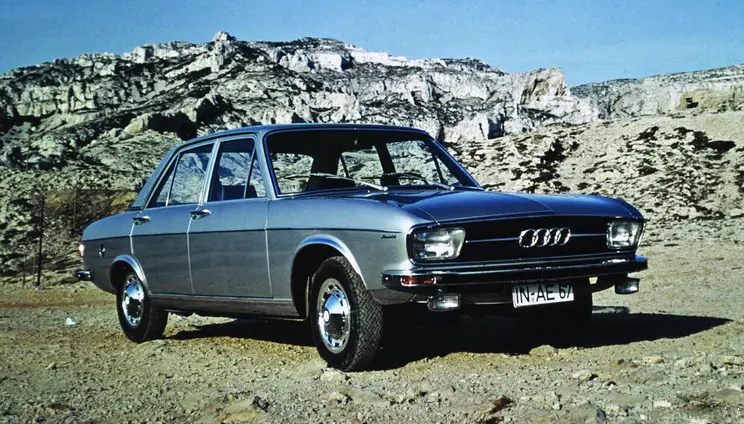
A few years later, things took a turn for the better. In 1977, when the Audi technical team was testing the winter performance of the Audi 100 in northern Finland, chassis engineer Jörg Bensinger discovered a strange phenomenon: the accompanying work vehicle, the Volkswagen Iltis, a four-wheel-drive military jeep, only had 70 Horsepower, always being left behind by the pack on the straights. However, once it enters a corner, it can easily overtake the high-horsepower front-wheel drive cars in the team.

Bensinger believes that the four-wheel drive system is the key to overtaking. So after returning to the company, he proposed to transplant the four-wheel drive system into Audi’s cars. Although the crossover style is popular in the current car market, in people’s minds at the time, there should be no intersection between four-wheel drive and sedans. Almost all management opposed this proposal, and only one person supported it, and that was Ferdinand Piesi, the future head of Volkswagen and then head of R&D at Audi.

After receiving the full support of his leadership, Bensinger could finally go ahead without any worries. However, there are not only conceptual problems but also technical difficulties that lie ahead. The problem mainly centers on how to fit a bulky traditional four-wheel drive system into a sedan with limited space. In the end, Audi did not use a bulky independent power distributor, but used a hollow shaft to transmit power to the center differential, which was transmitted to the rear wheels through a cardan shaft, and the hollow shaft was responsible for directing the power to the front wheels. This is the first generation quattro.
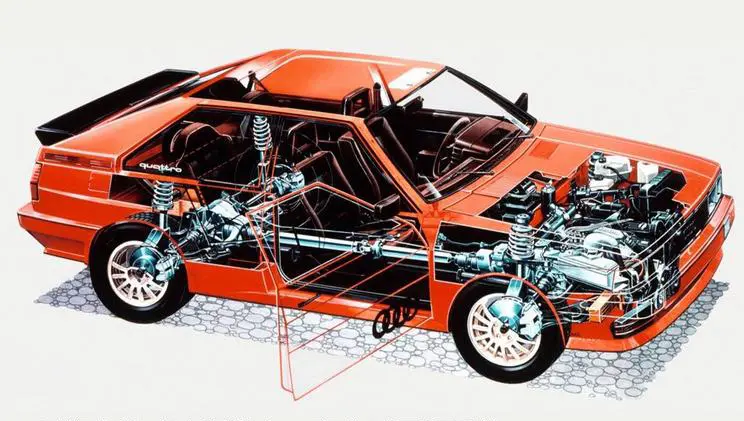
In 1980, Audi installed this four-wheel drive system into a two-door sedan based on the Audi 80 and named it Audi Quattro. The birth of Quattro gave Audi the confidence to return to the competition. In 1981, Audi brought a four-wheel drive vehicle into the WRC for the first time. At that time, the International Motor Sports Federation (FISA) allowed four-wheel drive vehicles to enter the WRC arena because opponents believed that these vehicles were not competitive.

However, Audi Quattro not only withstood the test, proving quattro’s technical strength and reliability under extreme racing conditions, but also won three race championships. After the first year of running-in, Audi quattro relied on its quattro technology to win the WRC annual team championship in 1982; then it won the driver championship in 1983; in 1984, it was the team and driver double annual championship. It is no exaggeration to say that Audi quattro has completed a powerful crushing in the WRC arena.

Audi does not limit its quattro four-wheel drive to the WRC. In fact, the story of WRC crushing opponents has also appeared repeatedly in top events such as the Pikes Peak Mountain Race, the Pan American Touring Car Series, and the German Touring Car Championship. In the 1980s, no other manufacturer except Audi could produce high-speed, lightweight quattro drive systems for large sedans.
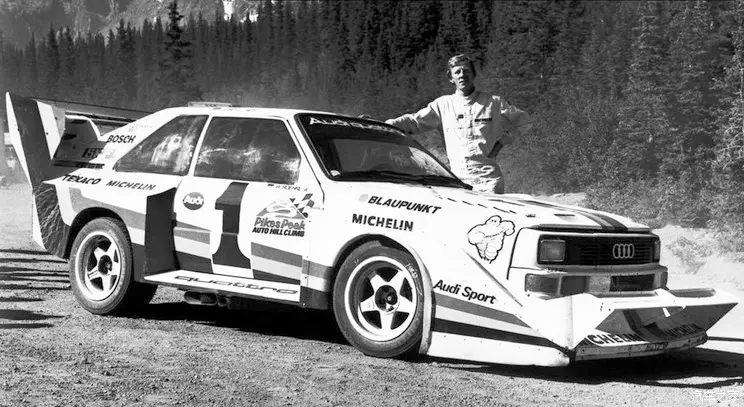
Quattro technology made its debut at the 1980 Geneva Motor Show. In 1986, Audi replaced the first-generation manual locking center differential with a Torsen differential to achieve the effect of flexibly distributing transmission torque. Outside of the racing arena, Audi has also brought quattro technology into civilian models: Audi 100, Audi 80, and later A6, A4, A8 and other models all have their own quattro versions, allowing ordinary consumers to experience the safety, stability, control fun and off-road performance brought by full-time four-wheel drive.

Born in ice and snow, and famous on the track, Audi quattro technology has continued to interpret its own legendary chapter for more than 40 years. From its debut in the competition to its widespread use in civilian vehicles, quattro has become a technical totem that the Audi brand is proud of, and has also laid a solid foundation for the development of Audi SUVs.
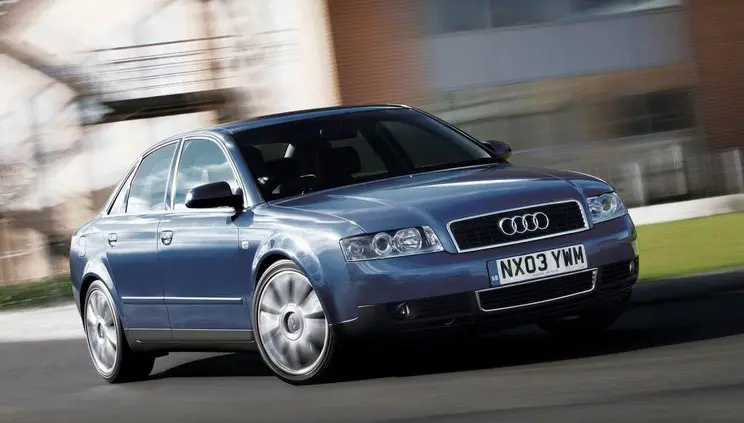
Audi Q7 (2005-2015)
The development plan for the Q7, the first member of the Audi SUV family, began in 2002. The new car is based on the Volkswagen Group’s PL71 platform, and the body shape is by Japanese designer Satoshi Wada. The Q7 has two design features of the Audi family at that time. One is the rounded lines and full contours to create a powerful shape; the other is Audi’s iconic “big mouth” grille. This classic element was first used in 2003. Appeared on the Nuvolari concept car, it strengthens the visual impact of the front face while meeting pedestrian protection regulations.

At the 2003 North American Auto Show, the Pikes Peak Concept concept car met the public as a prototype of the Audi Q7. Two years later, at the 2005 Frankfurt Motor Show, the production version was officially unveiled. The Audi Q7 is 5086mm long and has a wheelbase of 3002mm. It provides 3 rows of seats and can accommodate 7 passengers. In terms of workmanship, material selection, and manufacturing processes, Q7 maintains Audi’s uncompromising high-end quality and the high standards it has set in the industry.

In terms of power, the Q7 is equipped with two (3.6L, 4.2L) FSI automotive direct injection engines, and three (3.0T, 4.2T, 6.0T double supercharged) TDI turbodiesel direct injection engines, matched with a 6-speed automatic transmission. The fifth-generation quattro full-time four-wheel drive system equipped on the Q7 distributes torque to the front and rear axles in a ratio of 42:58 under normal driving conditions. Under extreme conditions, up to 65% of the torque can be transmitted to the front axle, or up to 85% of the torque is transmitted to the rear axle.

The adjustable air suspension can increase the vehicle’s ground clearance to 240mm, approach angle of 24°/departure angle of 25°, maximum wading depth of 535mm, maximum continuous climbing gradient of 31°, maximum driving inclination angle of 35° and a maximum of 24 ° uphill angle. In July 2006, the Audi Q7 entered the Chinese market in imported form, with an initial price range of 1.12-1.287 million yuan, continuing to maintain and consolidate Audi’s position as the leader in China’s high-end car market. The first-generation Audi Q7 had a life cycle of 10 years until it was replaced by the new-generation Q7 in 2015.
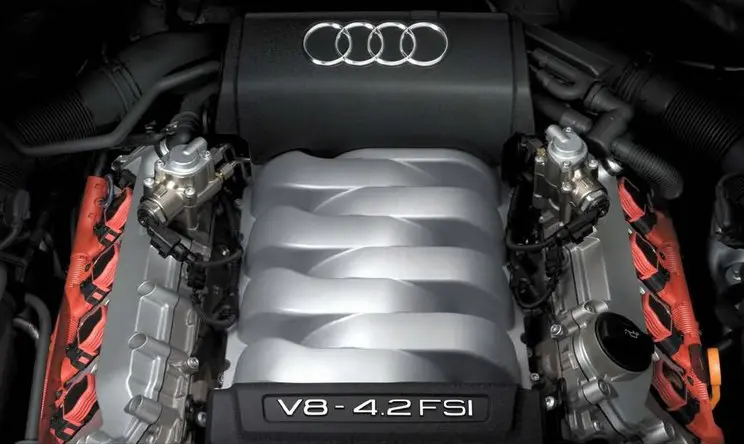
New Audi Q7 (2015-present)
In 2012, Audi showed a concept car called Crosslane Coupe. Many new designs, including a three-dimensional air intake grille and more tough lines, are reflected in the new Q7. At the 2015 North American Auto Show, Audi released the second-generation Q7. The new car is based on the Volkswagen Group’s MLB Evo platform and the body shape was designed by Wolfgang Egger. The length of the new Q7 is 5069mm and the wheelbase is 3001mm. Compared with the previous generation, it has been completely slimmed down and the feeling of bloat has been reduced a lot.
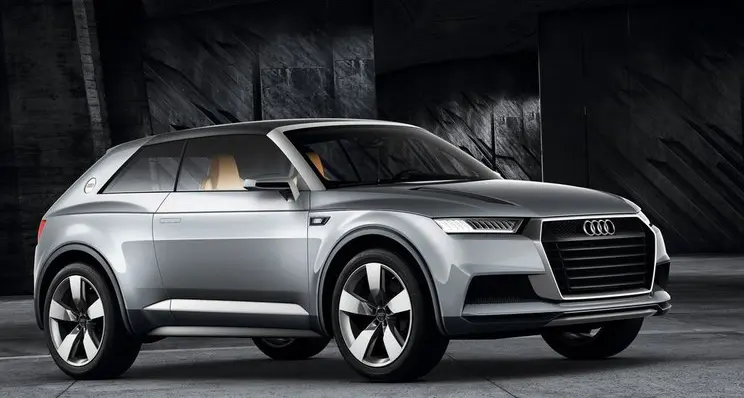
In terms of appearance, the second-generation Q7 adopts Audi’s new family-style design language, and its style has become more youthful and urban, emphasizing the exquisite luxury that urban groups value more. The new Q7 provides three sets of headlights with different configurations. The lowest model uses a xenon headlight + LED daytime running light design; The top model is equipped with Audi’s famous matrix LED headlight set. Due to the extensive use of aluminum alloy materials in the body, the weight of the car is reduced by 300kg.
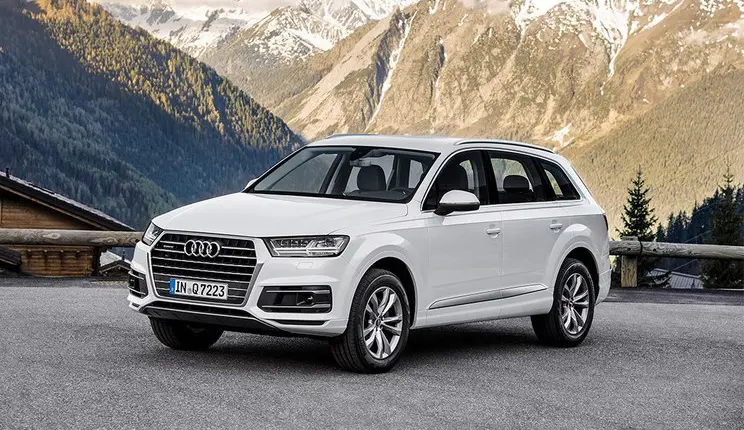 4
4
In the interior, a 12.3-inch LCD screen replaces the traditional pointer instrument panel, and the configuration includes a head-up display, night vision function, ACC adaptive cruise, panoramic imaging, B&O audio, 18-way adjustable electric seats that support massage function, etc. The power system of the second-generation Q7 provides three engines: 2.0 TFSI, 3.0 TFSI, and 3.0 TDI, which are matched with an 8-speed automatic transmission. At the same time, the entire series comes standard with a quattro full-time four-wheel drive system.

In 2016, Audi launched the new Q7 e-tron. The car uses a plug-in hybrid system composed of a 2.0 TFSI engine and an electric motor. The combined maximum output power reaches 367 horsepower and the cruising range in pure electric mode is 56km. The second-generation Q7 and Q7 e-tron are both imported and sold in China. In addition, Audi also launched the high-performance model SQ7, which is equipped with a 4.0T diesel engine equipped with an electronic turbocharger, with a maximum output of 435 horsepower.
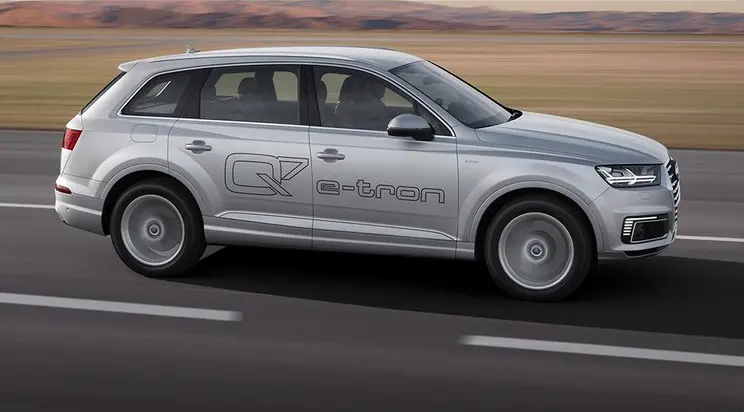
In 2019, the new Q7 underwent a product update that was comparable to a new generation. The new model provides laser headlights with high-definition matrix LED technology. The changes in the interior can be described as completely new. The new Q7 car adopts Audi’s latest family design, the Audi virtual cockpit composed of three screens, 30-color interior ambient lighting, and a significant reduction in physical buttons, giving it a sense of technology and keeping pace with the times.
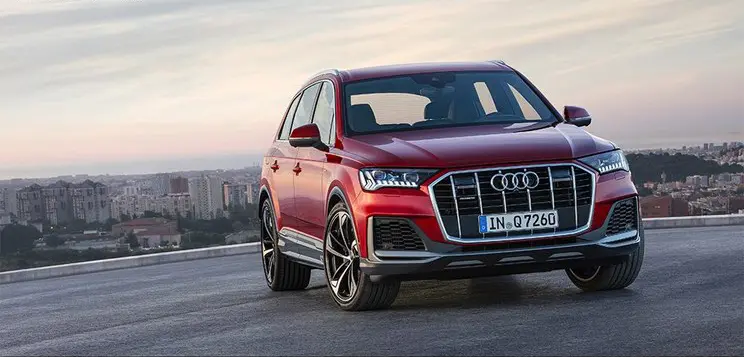

The power system has been upgraded to a more efficient and environmentally friendly combination. The 3.0L engine of the new Audi Q7 has been changed from the previous supercharger to a turbocharger + 48V light hybrid system. In addition, the new Q7 can be equipped with optional active anti-roll bars and rear-wheel steering systems, and can also be used with adaptive air suspension to provide variable ground clearance. The appropriate off-road mode can be selected via the Audi drive select dynamic handling system with seven modes. A variety of options that help improve comfort and control greatly enhance the competitiveness of the new Q7.

Audi Q5 (2008-2017)
Following the successful launch of the mid- to large-sized SUV Q7, Audi has turned its attention to the mid-sized luxury SUV market with huge potential and a wide audience. At the 2007 Los Angeles Auto Show, Audi brought a concept car called the Cross Cabriolet quattro. Although the car adopts a two-door convertible design, the ride height is similar to that of an SUV, and the dark plastic side skirts reinforce this feature. Its production version is Audi’s new mid-size SUV-Q5.

At the 2008 Beijing Auto Show in China, the Audi Q5 based on Volkswagen’s MLB longitudinal engine modular platform made its world premiere. This move demonstrated Audi’s emphasis on the Chinese market and also heralded Audi’s greater development potential in the Chinese market. From the overall styling point of view, the Audi Q5 is like the exquisite epitome of the Q7, offering two appearance style options: sports version and off-road version. The body dimensions of the Q5 are 4639mm, 1880mm and 1650mm, and the wheelbase is 2807mm.
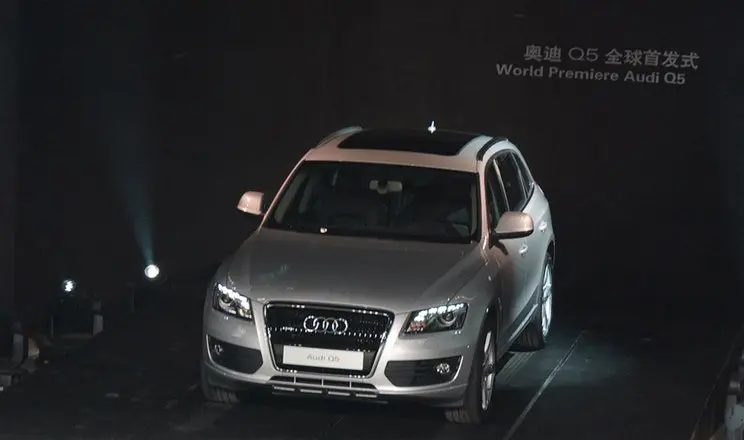
In terms of power, the Audi Q5 is equipped with 2.0TFSI and 3.2FSI gasoline engines and 2.0TDI and 3.0TDI diesel engines. It is matched with a 6-speed manual, 6-speed automatic or 7-speed dual-clutch gearbox, and some models can also be equipped with an 8-speed automatic gearbox. It is worth mentioning that Audi’s most proud quattro full-time four-wheel drive system appears on all models except the entry-level 2.0TDI model, which undoubtedly enhances the driving performance and handling stability of the Audi Q5.
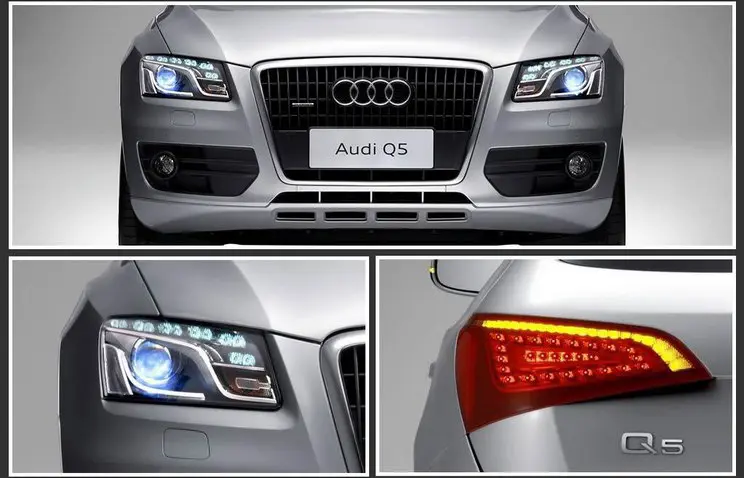
Since the birth of the Q5, Audi has announced that it will establish a new factory in Changchun, China, to produce the joint venture Q5 model. However, in order to meet the needs of Chinese consumers who are eager to try new models and prefer imported models, the Audi Q5 was the first to be sold in China as an imported car in 2009, priced at 577,000-678,000. In March 2010, the Audi Q5 produced in China, with significantly improved cost performance, made its debut, with an initial price range of 379,800-539,800.

Audi Q5 has also launched two special versions: Q5 hybrid and SQ5. Among them, the Q5 hybrid is equipped with a combination of 2.0TFSI gasoline engine and electric motor. The combined power of this powertrain reaches 245 horsepower, and it can travel 3 kilometers in pure electric mode. The high-performance SQ5 is available with both gasoline and diesel power. The gasoline version of the 3.0TFSI supercharged engine can produce a maximum power of 354 horsepower and accelerate from standstill to 100km/h in just 5.3 seconds. The diesel version of the 3.0TDI twin-turbocharged engine has a maximum power of 313 horsepower and takes 5.1 seconds to accelerate from standstill to 100km/h.

New Audi Q5 (2016-present)
At the 2016 Paris Auto Show, Audi released a new generation of Q5. Compared with the rounded shape of the first generation, the new car has a tougher appearance. The iconic “big mouth” air intake grille has a hexagonal shape and is matched with a three-dimensional chrome grille frame. , making the front face more powerful. The introduction of all-LED light sources not only makes up for the shortcomings of the previous generation Q5, which only had xenon lamps, but also further consolidates Audi’s advantages in lighting. The length, width and height of the new Q5 are 4660mm, 1890mm and 1660mm. In addition to the slightly smaller width, the length and height have increased slightly. The length, width and height of the new Q5 are 4660mm, 1890mm and 1660mm. In addition to the slightly smaller width, the length and height have increased slightly.

Thanks to the application of lightweight materials, the new Q5 built on the Volkswagen Group’s MLB evo platform has a curb weight that is 90kg lighter than the previous generation. In terms of power, it is equipped with the third-generation EA888 2.0T engine, in addition to 2.0TDI, 3.0TDI and other diesel engines of different displacements. The application of the new generation quattro ultra four-wheel drive system allows the new car to achieve a fully continuous and stable 100% front-drive mode. At the same time, the central drive shaft and rear differential housing can also stop rotating, thereby achieving fuel saving.

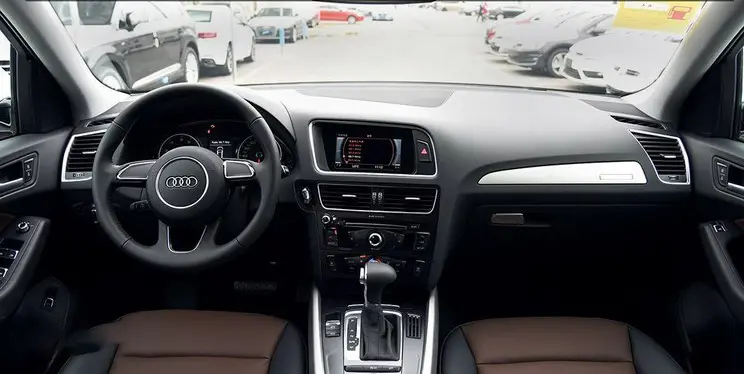
In March 2018, the Audi Q factory was completed and put into use, marking another important step in Audi’s strategic layout in the Chinese market. At the same time, the Audi Q5L also made its official debut, injecting new strength into Audi’s product line in the Chinese market. As can be seen from the “L” in the name, this is an extended model specially built for the Chinese market. Its wheelbase is 88mm longer than the overseas version of the Q5, reaching 2908mm. This change makes the Audi Q5L’s wheelbase completely surpass its competitors, providing Chinese consumers with more spacious interior space and higher ride comfort. In July of the same year, the Audi Q5L was launched in China, with an initial price range of 392,800-517,000.
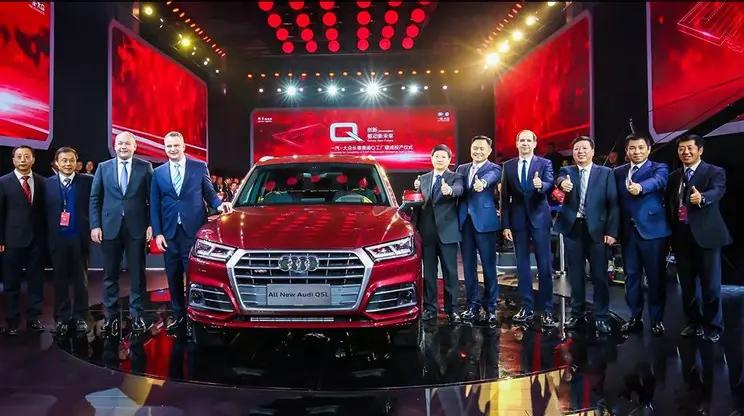
At the 2020 Beijing Auto Show, Audi Q5L Sportback made its world premiere. This car is based on the needs of Chinese users and is innovatively developed and localized by FAW-Audi ahead of Audi globally. And for the first time, it has achieved the world premiere of a heavyweight model simultaneously with the Audi Q5 Sportback standard version in China and Germany. It not only has the luxury and practicality of the ordinary Audi Q5L, but also incorporates a personalized walking coupe shape, with both youthful and sporty temperament. At the 2020 Guangzhou Auto Show, the Audi Q5L Sportback was launched in China, with an initial price range of 426,800-499,900.

At the 2017 North American Auto Show, the second-generation Audi SQ5 with a sportier appearance and a more powerful power system was officially released. Thanks to the MLB Evo platform, the curb weight of the new car has been reduced by 35kg compared to the previous generation. The power system is replaced with a 3.0T V6 turbocharged engine. Compared with the previous generation 3.0-liter V6 supercharged engine, the maximum power is still 354 horsepower, and the maximum torque increases by 30 Nm, reaching 500 Nm. At the 2021 Guangdong, Hong Kong and Macau Auto Show, the new Audi SQ5, equipped with a 48V mild hybrid system and a 0-100km/h acceleration time of 5.3 seconds, was imported to China with an initial launch price of 632,800 yuan.
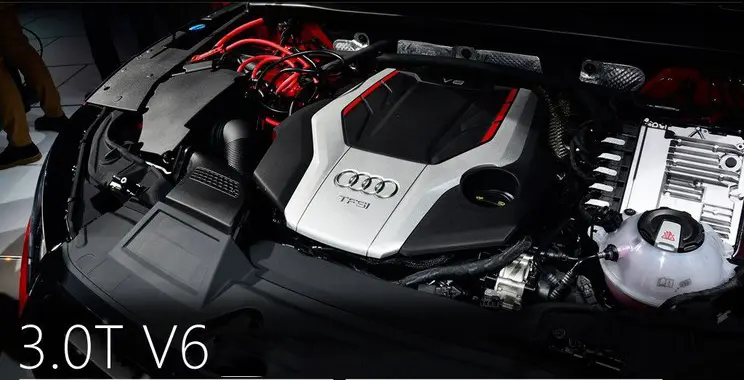
In November 2020, Audi’s performance coupe SUV SQ5 Sportback was released. The smooth roof line begins to drop from the B-pillar, showing an extremely smooth slip-back feel, highlighting the agility and softness of the body, and forming a curve behind the rear window. There is a small triangular window, and the rear of the car is also equipped with a highly three-dimensional ducktail, paired with a real exhaust layout with four outlets on both sides. At the 2022 Chengdu Auto Show in China, the Audi SQ5 Sportback will be sold in China as an import, priced at 638,800 yuan.

Conclusion: In this article, we reviewed the origin and development of Audi SUVs. Audi entered the SUV field relatively late and did not launch its first model, the Audi Q7, until 2005. However, with its tried-and-tested quattro full-time four-wheel drive system, the strength of the Q7 cannot be underestimated, laying a solid foundation for Audi to gain a foothold in the luxury SUV market. The subsequent launch of the Q5 gave Audi a firm foothold in the luxury SUV market.

